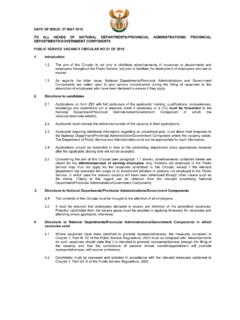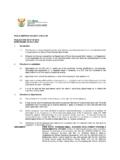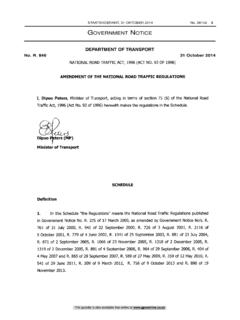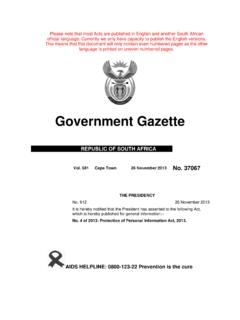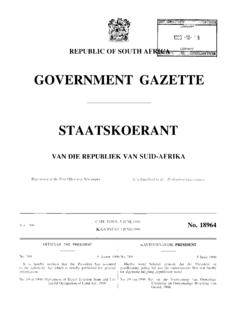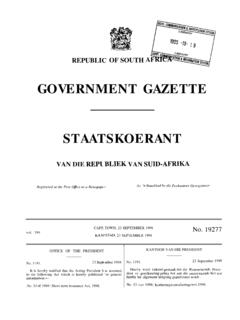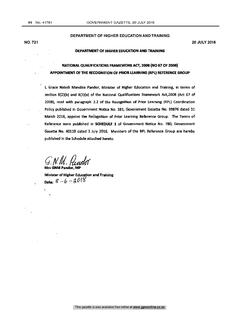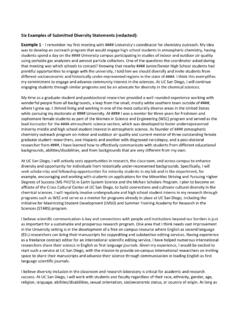Transcription of Industrial Policy Action Plan IPAP 2018/19-2020/21
1 The dti | IPAP: 2018/19 2020/21 1 the dti campus 77 Meintjies Street Sunnyside Pretoria, 0002 the dti Postal Address Private Bag X84, Pretoria, Gauteng, 0001 the dti Customer Contact Centre: 0861 843 384 Courier the dti, 12 Robert Sobukwe St, Sunnyside, Pretoria, Gauteng, 0002 the dti Website: ISBN: 978-0-621-46268-5 RP: 109/2018 the dti | IPAP: 2018/19 2020/21 2 .. 3 .. 8 .. 11 .. 33 .. 55 .. 61 .. 62 .. 71 .. 73 .. 85 .. 91 .. 93.
2 111 .. 112 .. 115 .. 121 .. 127 .. 134 .. 141 .. 160 .. 161 .. 170 9.. 176 .. 179 11.. 183 12.. 191 the dti | IPAP: 2018/19 2020/21 3 his is the tenth annual iteration of the Industrial Policy Action plan (IPAP) and the last of the present administration. In addition to providing an economic analysis of prevailing global and domestic economic conditions relevant to Industrial Policy ; time bound Action plans and programmes across a range of sectors and listing the key constraints to an optimal Industrial strategy, IPAP 2018 provides a summarised Legacy Report covering progress over the ten years of its existence.
3 The occasion also gives us a useful opportunity to reflect on the implementation of IPAP in the period since the adoption of the National Industrial Policy Framework (NIPF) and the experience of implementing successive, updated Action Plans over the course of one decade. Industrial Policy has the over-arching objective of enhancing the productive capabilities of the economy. In other words, Industrial Policy aims to increase the economy s ability to produce more and more complex and high value-added products with greater efficiency. In simple terms, this means to produce more value using less resources. Building the economy s Industrial capabilities is a continuous and long-term endeavour and technologies continuously evolve. 1 Other criteria: Provides strategic and operational leadership to the business; Is entrepreneurial and takes personal risk in the business; Does business in manufacturing and related sectors, with particular reference to IPAP and IDC focus areas; Makes a long-term commitment to the business and is not a short- to medium-term investor.
4 The key challenge to Industrial Policy is to incentivise investment in plant, technologies and skills that would have medium to long term benefits to the economy, but which the market would screen out because there is lower hanging fruit for short term returns. Industrial investment in targeted technologies and sectors spills over to the rest of the economy, resulting in generalised productivity improvement and increased welfare. Industrial Policy has traditionally placed a strong emphasis on the manufacturing sector, precisely because of such spill-over effects, and in terms of production disciplines, the mastery of new technologies and ultimately design capabilities. However, the boundary between what were historically considered primary sectors, such as mining and agriculture, and manufacturing industries and the services sectors, is becoming increasingly blurred.
5 For example, the process of producing high-value agricultural produce on large scale for exports has become extremely technologically complex; more so than some manufacturing processes. Similarly, the mechanisation and digitisation of deep-level and above-ground mining processes require the mastery of complex Industrial capabilities, including many technologies and disciplines associated with the digital Industrial revolution. In a nutshell, many primary sectors have become industrialised, and with time this will become even more the case. In addition, core to South Africa s Industrial Policy is the objective of transforming the racially skewed ownership, management and employment profile of the economy. The synergies between Industrial Policy and transformation are obvious.
6 If a product is imported, there is no possibility of building a transformed supply chain. Industrial Policy needs to make a concerted effort to ensure that support for investment is integrated with support for transformation. For example, the Black Industrialist Programme provides significant grant finance for investment in new plant, provided that the enterprise has at least a 50% black shareholding and/or exercises control over the In addition, then, to these matters of context, the following observations are critical, in our view, to the future of a successful domestic Industrial strategy. T the dti | IPAP: 2018/19 2020/21 4 Basic economic service delivery Firstly, basic economic service delivery needs to be in place for there to be effective Industrial Policy : As is now very widely accepted, the institutional failure that derives from pervasive corruption and rent-seeking in key SOCs must be rooted out from top to bottom.
7 On the supply side, SOCs must play a key enabling role in support of the general economic and Industrial effort by providing competitive and efficient electricity, rail and port logistics. On the demand side, they must support localisation, supplier development and black economic empowerment. Urgent attention must be given to the institutional renewal of public-sector monopolies which have been responsible for significant import leakages, debilitating and unsustainable increases in electricity, rail and port costs and attendant inefficiencies. Institutional coordination The realities of institutional coordination need to be carefully considered. Industrial Policy rests on multiple foundations and must embrace a complex set of interlocking and mutually supportive policies and programmes, held together by the vision set out in the National Development plan .
8 On the one hand, Industrial Policy must be a Policy of the whole of government and not just one or two departments. Policy coherence and programme alignment are a precondition for successful Industrial interventions. On the other hand, the reality is that building institutional capability and coherence is a slow, hard job, particularly given the unevenness of existing capabilities across the South African state. This being so, the only practical way to implement effective Industrial Policy is to learn by doing. An optimal Industrial effort requires carefully designed and calibrated Policy , against the background of increasingly uncertain, volatile and often potentially hostile - global market conditions. This effort must, of necessity, address both the structural fault-lines and the evolving dynamics of the domestic political economy; and it must encompass development- and investment-friendly smart regulation.
9 In the absence of Policy certainty, fragmentation in government, wilful non-compliance and corruption in private and public-sector institutions - all these and more - inevitably lead to sub-optimal outcomes. Industrial Policy in the global context The global context remains critical. The past decade of implementing South African Industrial strategy needs to be understood in relation to the global financial crisis of 2008-2009 and the extended economic crisis which flowed in its wake. The ensuing slump in global demand for many of South Africa commodities resulted in a slowing down of exports and investment in South Africa. In addition, surplus global capacity in the production of many key commodities has created huge challenges for South African industry.
10 For example, in the steel sector an inter-governmental task team was formed to deal with a crisis in the industry, through the judicious deployment of a range of Industrial Policy measures. While internationally recognised as a model of government-industry-labour social dialogue, it was essentially a holding Action . Much more still needs to be done to ensure that SA s domestic steel production is globally competitive and supports an increasingly globally competitive, value-adding, technology-intensive downstream sector. Industrial Policy is by its nature an iterative process: the building of Industrial capabilities is a step-by-step process. It is not possible for an economy to master highly advanced and complex Industrial capabilities, if basic and intermediate capabilities are not in place.
